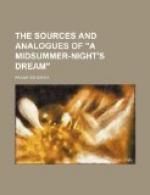[47] Alfred Nutt, The Fairy Mythology of Shakespeare (1900), p. 24. This little book is instructive and valuable.
[48] Nashe’s Works, ed. R.B. McKerrow, i. 347.
[49] Gower, however, does so, as early as the fourteenth century; Confessio Amantis, ii. 371.
[50] The opening of the beautiful Helgi and Sigrun Lay as translated by Vigfusson and York Powell in Corpus Poeticum Boreale (1883), i. 131; see also the editors’ Introduction, i. lxi, lxiv.
[51] Danish History, iii. 70, 77; vi. 181; cf. O. Elton’s translation (1894), pp. 84, 93, 223, and York Powell’s introduction thereto, lxiv.
[52] “It is worth noting that the Romance of Olger the Dane contains several late echoes of the old Helgi myth. a. The visit of the fairies by night to the new-born child ... e. His return to earth after death or disappearance ... Mark that Holgi is the true old form ... The old hero Holgi and the Carling peer Otgeir (Eadgar) are distinct persons confused by later tradition.”—Corpus Poeticum Boreale, i. cxxx.
“The Fates ... bestow endowments on the new-born child, as in the beautiful Helge Lay ... a point of the story which survives in the Ogier of the Chansons de Geste, wherein Eadgar (Otkerus or Otgerus) gets what belonged to Holger (Holge), the Helga til of Beowulf’s Lay.”—Saxo, Danish History, lxiv.
[53] Cf. Child’s Ballads, i. 319.
[54] In Huon of Bordeaux Merlin comes with King Arthur to Oberon’s death-bed; Arthur introduces him as his nephew, the son of Ogier the Dane and “my sister Morgan.”
[55] The mere mention of these subterranean explorations opens up an immense field of discussion and speculation that can here be only relegated to a note; we can treat at greater length none but those legends which bear directly on our subject. Odysseus visited Hades, Aeneas descended to Orcus or Tartarus, and they have their counterparts in every land and every mythology. Human aetiological tendencies supply explanations of any cavern or natural chasm—even a volcano must be the mouth of the entrance to hell or purgatory—from Taenarus, where Pluto carried off Proserpine, and the Sibyl’s cavern, whence Aeneas sought the lower regions, to the famous Lough Dearg in Donegal, the entrance to “St. Patrick’s Purgatory,” and the Peak cavern in Derbyshire. The student may begin his researches with T. Wright’s St. Patrick’s Purgatory (1844). A very common tale in Celtic literature is that of the visit of some hero to the underworld and his seizure of some gift of civilisation—just as Prometheus stole fire from heaven.
[56] Ballads, loc. cit.
[57] A version of Fytte I will be found in this book, pp. 122-132.
[58] See Child’s Ballads, No. 37, Thomas Rymer, i. 317-329; also the romance, Thomas of Erceldoune (E.E.T.S., 1875), where Prof. J.A.H. Murray prints all texts parallel, and adds a valuable introduction.




